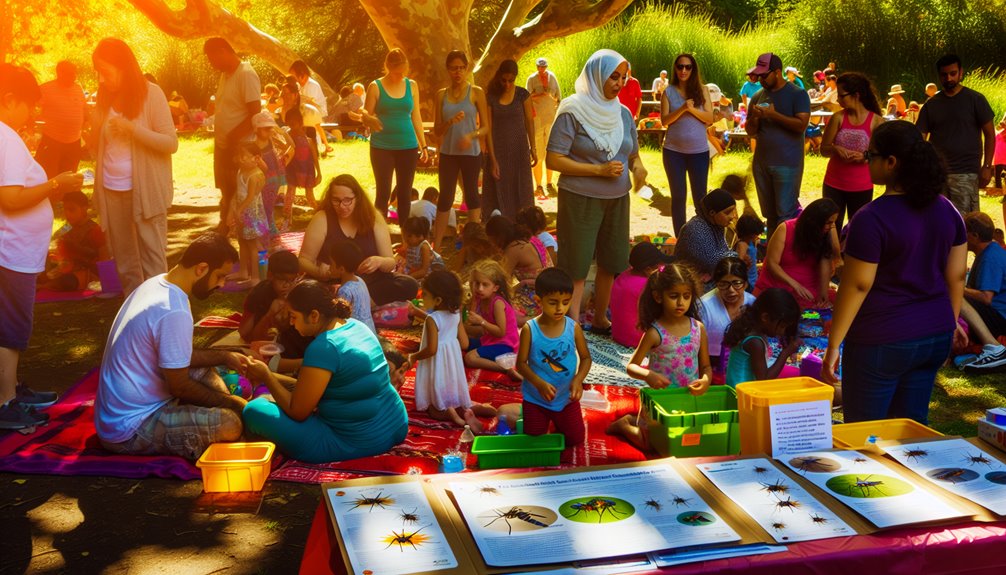You might think mosquitoes are just a nuisance, but they drive over 700 million infections annually, including dengue, malaria, and West Nile. Aedes aegypti can breed in a bottle cap, and warmer temperatures expand their range and season. Evidence shows simple measures—eliminating standing water, using EPA-registered repellents, and targeted larviciding—cut transmission risk. Yet gaps in surveillance, household behaviors, and climate resilience keep risk high. The question isn’t if they’ll bite—it’s what that bite could mean next.
The Growing Public Health Threat of Mosquito-Borne Diseases

Although mosquito bites seem trivial, the data show a fast-rising global health burden driven by vectors like Aedes aegypti and Anopheles. You face expanding risks: dengue cases have increased eightfold since 2000, malaria still kills hundreds of thousands annually, and West Nile circulates each summer. Climate variability, travel, and insecticide resistance widen exposure. To serve your community, prioritize early detection, vaccination where available, and rapid care pathways. Strengthen public awareness campaigns, promote disease prevention behaviors, and champion surveillance that integrates lab-confirmed cases with vector indices. Coordinate with schools, clinics, and faith groups to reach vulnerable neighbors and allocate resources where risk peaks.
How Mosquitoes Breed and Thrive in Urban and Rural Settings
Even in small, overlooked niches, mosquitoes exploit predictable water, heat, and human proximity to multiply fast. You’ll find breeding habitats wherever standing water persists—clogged gutters, rain barrels, planter saucers, and rural wetlands. Evidence shows urban vectors complete reproductive cycles in as few as 7–10 days under favorable environmental conditions. Rural sites produce high densities near livestock and irrigation. Align your efforts with seasonal patterns to cut risk.
- Map and remove micro-pools; verify after rainfall.
- Seal containers; maintain drainage; larvicide where water can’t be eliminated.
- Coordinate community control measures, monitor indices (HI, CI, BI), and document outcomes.
Climate Change and the Expanding Range of Vector Species

Because heat, humidity, and precipitation patterns are shifting, climate change is pushing mosquito vectors into higher latitudes, altitudes, and longer transmission seasons, raising risk in places with little prior exposure. You’re seeing Aedes and Anopheles expand via vector migration; studies show temperature thresholds as small as 1–2°C open new habitat and extend biting windows. Coastal flooding and urban heat islands intensify breeding suitability. You can lead climate adaptation by prioritizing surveillance in frontier zones, integrating meteorological data, and mapping vulnerability for seniors, outdoor workers, and underserved neighborhoods. Act early: calibrate larval control, remove standing water, and coordinate cross-jurisdictional response plans.
Understanding Transmission: From Bite to Illness
When a competent mosquito species feeds on a viremic or parasitemic host, it acquires pathogens that amplify in the midgut and disseminate to the salivary glands, setting up transmission during the next bite. You’re part of the protection chain when you understand the mosquito lifecycle and disease mechanisms. Evidence shows extrinsic incubation depends on temperature, species, and viral load, shaping risk windows.
1) Quantify exposure: track bite frequency, peak hours, and local case data to estimate transmission probability.
2) Prioritize hosts: protect infants, pregnant people, and immunocompromised individuals first.
3) Interrupt contact: align personal precautions with periods when vector competence and pathogen replication peak.
Community-Level Strategies That Actually Reduce Risk

Understanding bite timing, vector competence, and incubation windows lets you scale protection beyond your household to the neighborhood. You prioritize source reduction because 70–80% of vector breeding occurs in small, artificial containers. Map and drain standing water weekly; measure success with larval indices (Breteau Index below 5 signals lower risk). Use targeted larviciding where surveillance detects Aedes or Culex; rotate active ingredients to limit resistance. Launch community engagement and educational initiatives that align with local risk calendars, not convenience. Share transparent dashboards on trap counts and case clusters. Coordinate stormwater fixes, tire cleanup, and vacant-lot maintenance. Monitor outcomes and adjust.
Personal Protection: What Works and What Doesn’t
Even if your community program is strong, you cut bite risk fastest with proven personal measures and skip the hype. Focus on repellent efficacy, protective clothing, and exposure timing. Meta-analyses show DEET (20–30%), picaridin (20%), IR3535, and oil of lemon eucalyptus deliver the longest protection; bracelets, vitamin B, and ultrasounds don’t.
1) Choose tested repellents and reapply per label; higher concentration extends duration, not strength.
2) Wear protective clothing: long sleeves, permethrin-treated fabric, closed shoes; light colors reduce landing rates.
3) Reduce dusk–dawn exposure, use fans and screens.
For service work, protect yourself first so you can help others safely.
Targeting Hotspots: Data-Driven Surveillance and Response
Although mosquitoes seem ubiquitous, transmission risk clusters in predictable hotspots you can find and fix with data. You start by integrating case reports, trap counts, weather, and land-use to run hotspot mapping. Prioritize areas with high vector indices and recent infections. Validate signals with field audits—larval dips, ovitraps, and human case timelines. Then trigger tiered response interventions: source reduction, targeted larviciding, ultra-low-volume adulticiding when thresholds are exceeded, and community alerts. Track leading indicators—Breteau index, container positivity, parity rates—to gauge impact. If metrics don’t shift within set intervals, adjust tactics and redeploy resources. You protect more people, faster, with less waste.
Protecting Vulnerable Populations With Integrated Approaches
Start with the highest-risk groups—infants, pregnant people, older adults, outdoor workers, and unhoused residents—because they shoulder disproportionate mosquito-borne disease burdens. You prioritize vulnerable demographics using evidence on exposure, immunity, and access gaps. Deploy integrated solutions that combine surveillance, behavior support, and vector control, then evaluate outcomes.
- Pair targeted larval habitat reduction with EPA-registered repellents, permethrin-treated clothing for workers, and bed nets for unhoused residents; monitor bite rates and febrile illness.
- Coordinate prenatal clinics and senior services to distribute repellents, education, and rapid testing; track uptake and positive cases.
- Use multilingual alerts, heat-mapped outreach, and door-to-door source reduction; audit coverage and residual risk.
Conclusion
As the proud owner of Mosquito Eliminators of South MS, I understand the importance of keeping our community safe from the dangers posed by mosquitoes. Every step we take together toward effective mosquito control helps protect our families and friends from harmful diseases. I invite you to learn more about our services and how we can work together to create a healthier environment for everyone. Visit us at mosquitoeliminatorsms.com or give us a call at (601) 336-2277. Together, we can keep those pesky mosquitoes at bay and enjoy our beautiful Mississippi outdoors with peace of mind!

